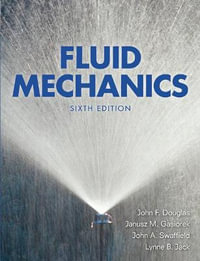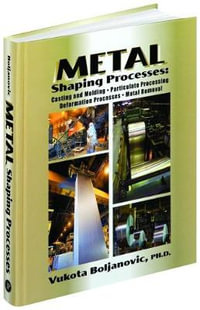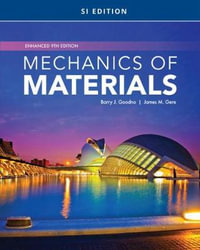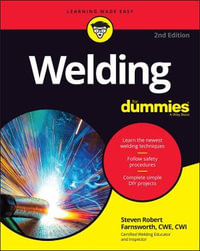
Analysis and Modelling of Non-Steady Flow in Pipe and Channel Networks
By: Vinko Jovic
Hardcover | 19 April 2013 | Edition Number 1
At a Glance
544 Pages
25.07 x 17.78 x 2.99
Hardcover
$307.75
or 4 interest-free payments of $76.94 with
orAims to ship in 10 to 15 business days
Analysis and Modelling of Non-Steady Flow in Pipe and Channel Networks deals with flows in pipes and channel networks from the standpoints of hydraulics and modelling techniques and methods. These engineering problems occur in the course of the design and construction of hydroenergy plants, water-supply and other systems. In this book, the author presents his experience in solving these problems from the early 1970s to the present day. During this period new methods of solving hydraulic problems have evolved, due to the development of computers and numerical methods.
This book is accompanied by a website which hosts the author's software package, Simpip (an abbreviation of simulation of pipe flow) for solving non-steady pipe flow using the finite element method. The program also covers flows in channels. The book presents the numerical core of the SimpipCore program (written in Fortran).
Key features:
- Presents the theory and practice of modelling different flows in hydraulic networks
- Takes a systematic approach and addresses the topic from the fundamentals
- Presents numerical solutions based on finite element analysis
- Accompanied by a website hosting supporting material including the SimpipCore project as a standalone program
Analysis and Modelling of Non-Steady Flow in Pipe and Channel Networks is an ideal reference book for engineers, practitioners and graduate students across engineering disciplines.
Preface xiii
1 Hydraulic Networks 1
1.1 Finite element technique 1
1.1.1 Functional approximations 1
1.1.2 Discretization, finite element mesh 3
1.1.3 Approximate solution of differential equations 6
1.2 Unified hydraulic networks 21
1.3 Equation system 23
1.3.1 Elemental equations 23
1.3.2 Nodal equations 24
1.3.3 Fundamental system 25
1.4 Boundary conditions 28
1.4.1 Natural boundary conditions 28
1.4.2 Essential boundary conditions 30
1.5 Finite element matrix and vector 30
Reference 36
Further reading 36
2 Modelling of Incompressible Fluid Flow 37
2.1 Steady flow of an incompressible fluid 37
2.1.1 Equation of steady flow in pipes 37
2.1.2 Subroutine SteadyPipeMtx 40
2.1.3 Algorithms and procedures 42
2.1.4 Frontal procedure 45
2.1.5 Frontal solution of steady problem 51
2.1.6 Steady test example 57
2.2 Gradually varied flow in time 59
2.2.1 Time-dependent variability 59
2.2.2 Quasi non-steady model 60
2.2.3 Subroutine QuasiUnsteadyPipeMtx 61
2.2.4 Frontal solution of unsteady problem 63
2.2.5 Quasi-unsteady test example 65
2.3 Unsteady flow of an incompressible fluid 65
2.3.1 Dynamic equation 65
2.3.2 Subroutine RgdUnsteadyPipeMtx 68
2.3.3 Incompressible fluid acceleration 69
2.3.4 Acceleration test 72
2.3.5 Rigid test example 72
References 75
Further Reading 75
3 Natural Boundary Condition Objects 77
3.1 Tank object 77
3.1.1 Tank dimensioning 77
3.1.2 Tank model 79
3.1.3 Tank test examples 83
3.2 Storage 90
3.2.1 Storage equation 90
3.2.2 Fundamental system vector and matrix updating 91
3.3 Surge tank 91
3.3.1 Surge tank role in the hydropower plant 91
3.3.2 Surge tank types 94
3.3.3 Equations of oscillations in the supply system 99
3.3.4 Cylindrical surge tank 101
3.3.5 Model of a simple surge tank with upper and lower chamber 108
3.3.6 Differential surge tank model 112
3.3.7 Example 117
3.4 Vessel 121
3.4.1 Simple vessel 121
3.4.2 Vessel with air valves 124
3.4.3 Vessel model 126
3.4.4 Example 127
3.5 Air valves 128
3.5.1 Air valve positioning 128
3.5.2 Air valve model 133
3.6 Outlets 135
3.6.1 Discharge curves 135
3.6.2 Outlet model 137
Reference 138
Further reading 138
4 Water Hammer – Classic Theory 141
4.1 Description of the phenomenon 141
4.1.1 Travel of a surge wave following the sudden halt of a locomotive 141
4.1.2 Pressure wave propagation after sudden valve closure 141
4.1.3 Pressure increase due to a sudden flow arrest – the Joukowsky water hammer 143
4.2 Water hammer celerity 143
4.2.1 Relative movement of the coordinate system 143
4.2.2 Differential pressure and velocity changes at the water hammer front 145
4.2.3 Water hammer celerity in circular pipes 147
4.3 Water hammer phases 149
4.3.1 Sudden Flow Stop, Velocity Change V0 → 0 151
4.3.2 Sudden Pipe Filling, Velocity Change 0 → V0 154
4.3.3 Sudden Filling of Blind Pipe, Velocity Change 0 → V0 156
4.3.4 Sudden valve opening 159
4.3.5 Sudden forced inflow 161
4.4 Under-pressure and column separation 164
4.5 Influence of extreme friction 167
4.6 Gradual velocity changes 171
4.6.1 Gradual valve closing 171
4.6.2 Linear flow arrest 174
4.7 Influence of outflow area change 176
4.7.1 Graphic solution 178
4.7.2 Modified graphical procedure 179
4.8 Real closure laws 180
4.9 Water hammer propagation through branches 181
4.10 Complex pipelines 183
4.11 Wave kinematics 183
4.11.1 Wave functions 183
4.11.2 General solution 187
Reference 187
Further reading 187
5 Equations of Non-steady Flow in Pipes 189
5.1 Equation of state 189
5.1.1 p,T phase diagram 189
5.1.2 p,V phase diagram 190
5.2 Flow of an ideal fluid in a streamtube 195
5.2.1 Flow kinematics along a streamtube 195
5.2.2 Flow dynamics along a streamtube 198
5.3 The real flow velocity profile 202
5.3.1 Reynolds number, flow regimes 202
5.3.2 Velocity profile in the developed boundary layer 203
5.3.3 Calculations at the cross-section 204
5.4 Control volume 205
5.5 Mass conservation, equation of continuity 206
5.5.1 Integral form 206
5.5.2 Differential form 207
5.5.3 Elastic liquid 207
5.5.4 Compressible liquid 209
5.6 Energy conservation law, the dynamic equation 209
5.6.1 Total energy of the control volume 209
5.6.2 Rate of change of internal energy 210
5.6.3 Rate of change of potential energy 210
5.6.4 Rate of change of kinetic energy 210
5.6.5 Power of normal forces 211
5.6.6 Power of resistance forces 212
5.6.7 Dynamic equation 212
5.6.8 Flow resistances, the dynamic equation discussion 213
5.7 Flow models 215
5.7.1 Steady flow 215
5.7.2 Non-steady flow 217
5.8 Characteristic equations 220
5.8.1 Elastic liquid 220
5.8.2 Compressible fluid 223
5.9 Analytical solutions 225
5.9.1 Linearization of equations – wave equations 225
5.9.2 Riemann general solution 226
5.9.3 Some analytical solutions of water hammer 227
Reference 229
Further reading 229
6 Modelling of Non-steady Flow of Compressible Liquid in Pipes 231
6.1 Solution by the method of characteristics 231
6.1.1 Characteristic equations 231
6.1.2 Integration of characteristic equations, wave functions 232
6.1.3 Integration of Characteristic Equations, Variables H, V 234
6.1.4 The water hammer is the pipe with no resistance 235
6.1.5 Water hammers in pipes with friction 243
6.2 Subroutine UnsteadyPipeMtx 251
6.2.1 Subroutine FemUnsteadyPipeMtx 252
6.2.2 Subroutine ChtxUnsteadyPipeMtx 255
6.3 Comparison tests 261
6.3.1 Test example 261
6.3.2 Conclusion 263
Further reading 264
7 Valves and Joints 265
7.1 Valves 265
7.1.1 Local energy head losses at valves 265
7.1.2 Valve status 267
7.1.3 Steady flow modelling 267
7.1.4 Non-steady flow modelling 269
7.2 Joints 279
7.2.1 Energy head losses at joints 279
7.2.2 Steady flow modelling 279
7.2.3 Non-steady flow modelling 282
7.3 Test example 288
Reference 290
Further reading 290
8 Pumping Units 291
8.1 Introduction 291
8.2 Euler’s equations of turbo engines 291
8.3 Normal characteristics of the pump 295
8.4 Dimensionless pump characteristics 301
8.5 Pump specific speed 303
8.6 Complete characteristics of turbo engine 305
8.6.1 Normal and abnormal operation 305
8.6.2 Presentation of turbo engine characteristics depending on the direction of rotation 305
8.6.3 Knapp circle diagram 305
8.6.4 Suter curves 308
8.7 Drive engines 310
8.7.1 Asynchronous or induction motor 310
8.7.2 Adjustment of rotational speed by frequency variation 311
8.7.3 Pumping unit operation 312
8.8 Numerical model of pumping units 314
8.8.1 Normal pump operation 314
8.8.2 Reconstruction of complete characteristics from normal characteristics 318
8.8.3 Reconstruction of a hypothetic pumping unit 321
8.8.4 Reconstruction of the electric motor torque curve 322
8.9 Pumping element matrices 323
8.9.1 Steady flow modelling 323
8.9.2 Unsteady flow modelling 327
8.10 Examples of transient operation stage modelling 333
8.10.1 Test example (A) 334
8.10.2 Test example (B) 336
8.10.3 Test example (C) 339
8.10.4 Test example (D) 341
8.11 Analysis of operation and types of protection against pressure excesses 345
8.11.1 Normal and accidental operation 345
8.11.2 Layout 345
8.11.3 Supply pipeline, suction basin 346
8.11.4 Pressure pipeline and pumping station 348
8.11.5 Booster station 350
8.12 Something about protection of sewage pressure pipelines 353
8.13 Pumping units in a pressurized system with no tank 355
8.13.1 Introduction 355
8.13.2 Pumping unit regulation by pressure switches 355
8.13.3 Hydrophor regulation 358
8.13.4 Pumping unit regulation by variable rotational speed 360
Reference 362
Further reading 362
9 Open Channel Flow 363
9.1 Introduction 363
9.2 Steady flow in a mildly sloping channel 363
9.3 Uniform flow in a mildly sloping channel 365
9.3.1 Uniform flow velocity in open channel 365
9.3.2 Conveyance, discharge curve 368
9.3.3 Specific energy in a cross-section: Froude number 372
9.3.4 Uniform flow programming solution 377
9.4 Non-uniform gradually varied flow 378
9.4.1 Non-uniform flow characteristics 378
9.4.2 Water level differential equation 380
9.4.3 Water level shapes in prismatic channels 382
9.4.4 Transitions between supercritical and subcritical flow, hydraulic jump 383
9.4.5 Water level shapes in a non-prismatic channel 391
9.4.6 Gradually varied flow programming solutions 395
9.5 Sudden changes in cross-sections 398
9.6 Steady flow modelling 401
9.6.1 Channel stretch discretization 401
9.6.2 Initialization of channel stretches 402
9.6.3 Subroutine SubCriticalSteadyChannelMtx 404
9.6.4 Subroutine SuperCriticalSteadyChannelMtx 406
9.7 Wave kinematics in channels 407
9.7.1 Propagation of positive and negative waves 407
9.7.2 Velocity of the wave of finite amplitude 407
9.7.3 Elementary wave celerity 409
9.7.4 Shape of positive and negative waves 411
9.7.5 Standing wave – hydraulic jump 412
9.7.6 Wave propagation through transitional stretches 413
9.8 Equations of non-steady flow in open channels 414
9.8.1 Continuity equation 414
9.8.2 Dynamic equation 416
9.8.3 Law of momentum conservation 417
9.9 Equation of characteristics 422
9.9.1 Transformation of non-steady flow equations 422
9.9.2 Procedure of transformation into characteristics 423
9.10 Initial and boundary conditions 424
9.11 Non-steady flow modelling 425
9.11.1 Integration along characteristics 425
9.11.2 Matrix and vector of the channel finite element 427
9.11.3 Test examples 431
References 434
Further reading 435
10 Numerical Modelling in Karst 437
10.1 Underground karst flows 437
10.1.1 Introduction 437
10.1.2 Investigation works in karst catchment 437
10.1.3 The main development forms of karst phenomena in the Dinaric area 438
10.1.4 The size of the catchment 443
10.2 Conveyance of the karst channel system 446
10.2.1 Transformation of rainfall into spring hydrographs 446
10.2.2 Linear filtration law 447
10.2.3 Turbulent filtration law 449
10.2.4 Complex flow, channel flow, and filtration 451
10.3 Modelling of karst channel flows 453
10.3.1 Karst channel finite elements 453
10.3.2 Subroutine SteadyKanalMtx 454
10.3.3 Subroutine UnsteadyKanalMtx 456
10.3.4 Tests 458
10.4 Method of catchment discretization 463
10.4.1 Discretization of karst catchment channel system without diffuse flow 463
10.4.2 Equation of the underground accumulation of a karst sub-catchment 466
10.5 Rainfall transformation 468
10.5.1 Uniform input hydrograph 468
10.5.2 Rainfall at the catchment 473
10.6 Discretization of karst catchment with diffuse and channel flow 474
References 477
Further reading 477
11 Convective-dispersive Flows 479
11.1 Introduction 479
11.2 A reminder of continuum mechanics 479
11.3 Hydrodynamic dispersion 483
11.4 Equations of convective-dispersive heat transfer 485
11.5 Exact solutions of convective-dispersive equation 487
11.5.1 Convective equation 487
11.5.2 Convective-dispersive equation 488
11.5.3 Transformation of the convective-dispersive equation 490
11.6 Numerical modelling in a hydraulic network 490
11.6.1 The selection of solution basis, shape functions 490
11.6.2 Elemental equations: equation integration on the finite element 492
11.6.3 Nodal equations 495
11.6.4 Boundary conditions 495
11.6.5 Matrix and vector of finite element 496
11.6.6 Numeric solution test 497
11.6.7 Heat exchange of water table 499
11.6.8 Equilibrium temperature and linearization 500
11.6.9 Temperature disturbance caused by artificial sources 501
References 503
Further reading 503
12 Hydraulic Vibrations in Networks 505
12.1 Introduction 505
12.2 Vibration equations of a pipe element 506
12.3 Harmonic solution for the pipe element 508
12.4 Harmonic solutions in the network 509
12.5 Vibration source modelling 512
12.6 Hints to implementation in SimpipCore 512
12.7 Illustrative examples 515
Reference 518
Further reading 518
Index 519
ISBN: 9781118532140
ISBN-10: 1118532147
Published: 19th April 2013
Format: Hardcover
Language: English
Number of Pages: 544
Audience: Professional and Scholarly
Publisher: John Wiley & Sons (UK)
Country of Publication: US
Edition Number: 1
Dimensions (cm): 25.07 x 17.78 x 2.99
Weight (kg): 0.96
Shipping
| Standard Shipping | Express Shipping | |
|---|---|---|
| Metro postcodes: | $9.99 | $14.95 |
| Regional postcodes: | $9.99 | $14.95 |
| Rural postcodes: | $9.99 | $14.95 |
How to return your order
At Booktopia, we offer hassle-free returns in accordance with our returns policy. If you wish to return an item, please get in touch with Booktopia Customer Care.
Additional postage charges may be applicable.
Defective items
If there is a problem with any of the items received for your order then the Booktopia Customer Care team is ready to assist you.
For more info please visit our Help Centre.
You Can Find This Book In

Structural Health Monitoring Using Emerging Signal Processing Approaches with Artificial Intelligence Algorithms
Hardcover
RRP $315.00
$222.90
OFF
This product is categorised by
- Non-FictionEngineering & TechnologyMechanical Engineering & MaterialsMaterials ScienceMechanics of FluidsFlow
- Non-FictionEngineering & TechnologyIndustrial Chemistry & Manufacturing TechnologiesIndustrial ChemistryChemical Engineering
- Non-FictionSciencePhysics
- Non-FictionEngineering & TechnologyMechanical Engineering & MaterialsMechanical Engineering
- Non-FictionEngineering & TechnologyBiochemical Engineering
- Non-FictionEngineering & TechnologyMechanical Engineering & Materials






















